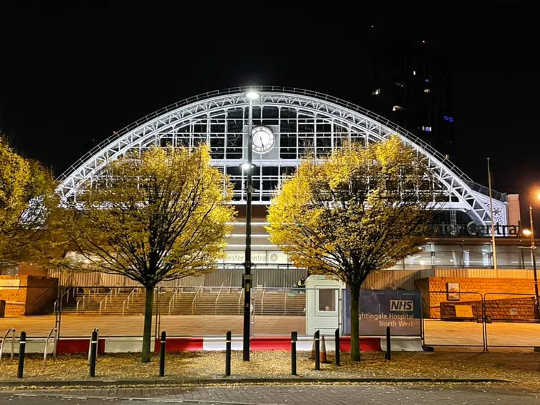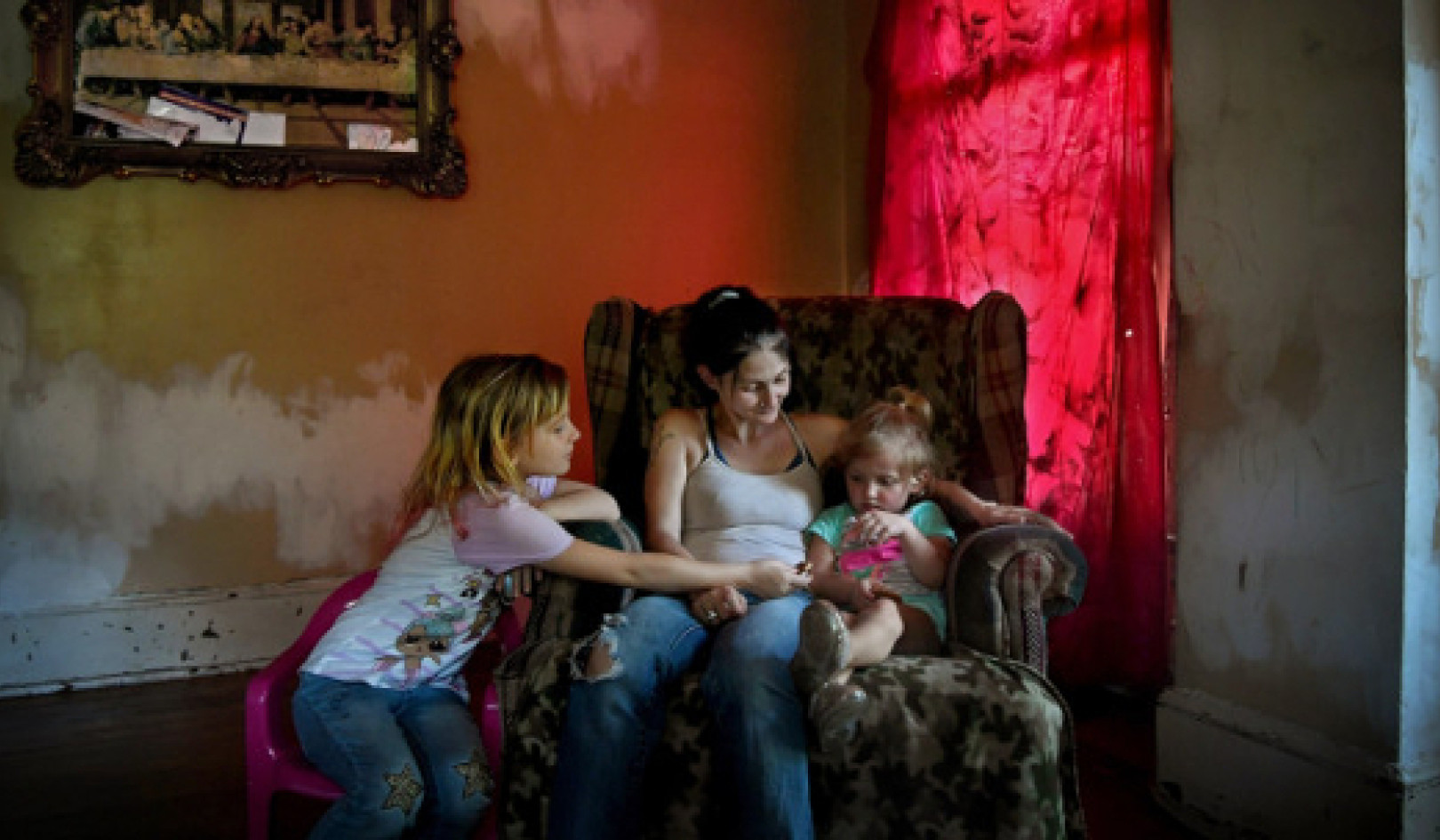As the coronavirus pandemic has moved around the world, cities have gone into lockdown and people have been encouraged to stay at home. In many places, curfews have been introduced.
Back in spring under the first UK lockdown, I went on numerous night walks in my home city of Manchester. I was struck by several things. Without traffic or trains, birdsong prevailed in this peculiar quietness. The air was fresh and crisp without the usual pollution. Yet, the artificial lights of the city at night still blazed, for no one.
Now, as England enters a second national lockdown, urban landscapes remain just as bright. It’s a similar situation around the globe, a powerful reminder of the wasteful ways we have become so accustomed to that we don’t even think about them.

Nightingale Hospital North West, city centre Manchester, 8 November 2020. Nick Dunn @darkskythinking/instagram
Light pollution is a big problem, not just because of the needless energy and money that it represents. Light is everywhere, an often-uninvited byproduct of our contemporary lives, shining from the devices we use and through the environments we inhabit.
Darkness, meanwhile, appears unwanted. How did we get to the point where if an urban landscape is not dazzling with light it must be troubling, even threatening?
From dark to light
Since the Enlightenment, Western culture has been closely bound with ideas of illumination and darkness as representative of good and evil. Shining a light on all things meant the pursuit of truth, purity, knowledge and wisdom. Darkness, by contrast, was associated with ignorance, deviancy, malevolence and barbarism.
Between the 16th and 18th centuries in Europe, for example, changes in attitudes and beliefs toward the night were important in framing perceptions of darkness that have endured. Transformations in societies gave rise to new opportunities for labour and leisure – which, coupled with the evolution of artificial illumination and street lighting, recast the night as an expansion of the day. Rather than being embraced, darkness was viewed as something to be banished with light.
But this view was not necessarily shared by other cultures. For example, in his 1933 classic In Praise of Shadows, the Japanese author Jun'ichir? Tanizaki pointed out the absurdity of greater and greater quantities of light. Instead, he celebrated the delicate and nuanced aspects of everyday life that were rapidly being lost as artificial illumination took over:
The progressive Westerner is determined always to better his lot. From candle to oil lamp, oil lamp to gaslight, gaslight to electric light – his quest for a brighter light never ceases, he spares no pains to eradicate even the minutest shadow.
In the context of many city centres today, darkness is unwanted – connected to criminal, immoral and sinister behaviour. Yet recent research by engineering firm Arup has shown that some of these concerns might be misplaced. Further research has shown that cities need a better understanding of light to help tackle inequality. It can be used to promote civic life and help create urban spaces that are vibrant, accessible and comfortable for the diverse people who share them.
Meanwhile values of light, clarity, cleanliness and coherence in urban landscapes have been transferred across the global experience of culture more widely, resulting in a worldwide disappearance of the night sky.
The cost of light
This is not a small issue. Scientists are increasingly referring to this as a global challenge. The International Dark-Sky Association has shown that the waste in both energy and money is huge – in the US alone this adds up to $3.3 billion and an unnecessary release of 21 million tonnes of carbon dioxide each year. Of greater concern are the devastating impacts over-illumination and light pollution is having upon human health, other species, and the planet’s ecosystems.
The circadian rhythms of humans are disrupted by exposure to artificial light at night, making those working on-call, long hours or in shift work prone to diseases such as cancer, cardiovascular disease, diabetes, obesity and gastrointestinal disorders. Britain’s night workers now account for one in nine employees, so this is a significant issue.
Millions of migrating birds become disorientated by electric lights, causing them to crash into buildings, while migrating sea turtles and beetles that use moonlight become disorientated.
It is clear we need alternatives – and quickly. Instead of reducing lighting pollution, new LED technologies actually increased it. This is because they have been rolled out with an emphasis on economic savings rather than scrutinised and applied with the nuance they are capable of in terms of array, colour, and power. Shifting the emphasis from quantity to quality is crucial so that we can appreciate different types of lighting appropriate to different contexts, such as the lighting scheme for Moscow’s Zaryadye Park, designed by US design studio Diller Scofidio + Renfro, which reflects existing sources of light.

Zaryadye Park, Moscow. Ekaterina Bykova/Shutterstock.com
Valuing darkness
Dark skies have value. They are a profoundly wonderful yet highly threatened natural asset. It is unsurprising that people are increasingly rediscovering the joys of walking at night, whether in cities or the countryside.
We need a new conception of the dark and new visions for places that enable us to reconnect with the night sky through more responsible and less environmentally harmful lighting. Although intended as art, Thierry Cohen’s Villes éteintes (Darkened Cities) photographic series is powerful in the way it conveys how future cities could be with a more responsible and ecological approach to urban illumination. His photographs are a reminder of our connection to the cosmos and the dark skies many miss out on.
Among the complex and cascading issues that climate change presents, engaging with the potential of darkness in our cities is more important and urgent than ever before. Urban development around the world remains uneven and it would be easy to repeat and increase the problems we have already caused with light pollution. It is time for us to embrace the darkness.
About the Author
Nick Dunn, Professor of Urban Design, Lancaster University
This article is republished from The Conversation under a Creative Commons license. Read the original article.
Books on The Environment from Amazon's Best Sellers list
"Silent Spring"
by Rachel Carson
This classic book is a landmark in the history of environmentalism, drawing attention to the harmful effects of pesticides and their impact on the natural world. Carson's work helped to inspire the modern environmental movement and remains relevant today, as we continue to grapple with the challenges of environmental health.
Click for more info or to order
"The Uninhabitable Earth: Life After Warming"
by David Wallace-Wells
In this book, David Wallace-Wells offers a stark warning about the devastating effects of climate change and the urgent need to address this global crisis. The book draws on scientific research and real-world examples to provide a sobering look at the future we face if we fail to take action.
Click for more info or to order
"The Hidden Life of Trees: What They Feel, How They Communicate?Discoveries from A Secret World"
by Peter Wohlleben
In this book, Peter Wohlleben explores the fascinating world of trees and their role in the ecosystem. The book draws on scientific research and Wohlleben's own experiences as a forester to offer insights into the complex ways that trees interact with one another and the natural world.
Click for more info or to order
"Our House Is on Fire: Scenes of a Family and a Planet in Crisis"
by Greta Thunberg, Svante Thunberg, and Malena Ernman
In this book, climate activist Greta Thunberg and her family offer a personal account of their journey to raise awareness about the urgent need to address climate change. The book provides a powerful and moving account of the challenges we face and the need for action.
Click for more info or to order
"The Sixth Extinction: An Unnatural History"
by Elizabeth Kolbert
In this book, Elizabeth Kolbert explores the ongoing mass extinction of species caused by human activity, drawing on scientific research and real-world examples to provide a sobering look at the impact of human activity on the natural world. The book offers a compelling call to action to protect the diversity of life on Earth.
























